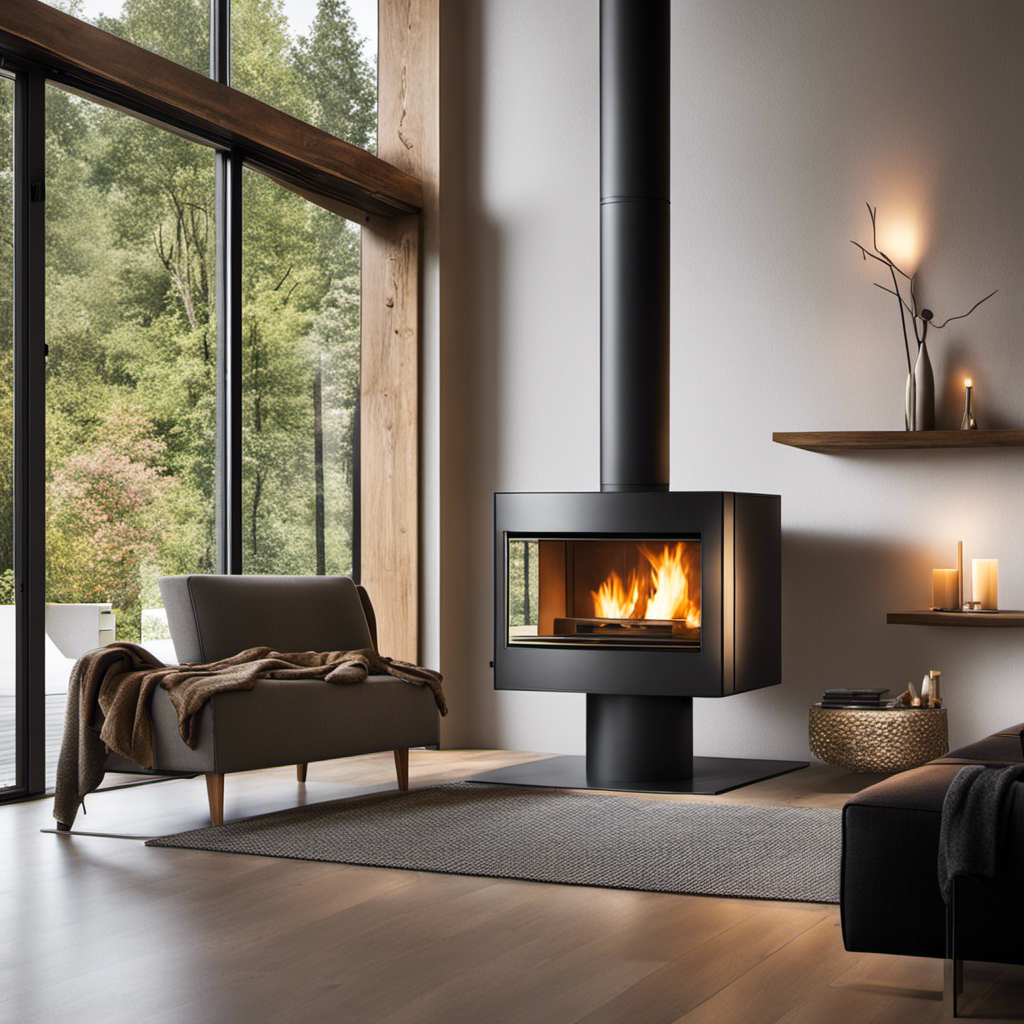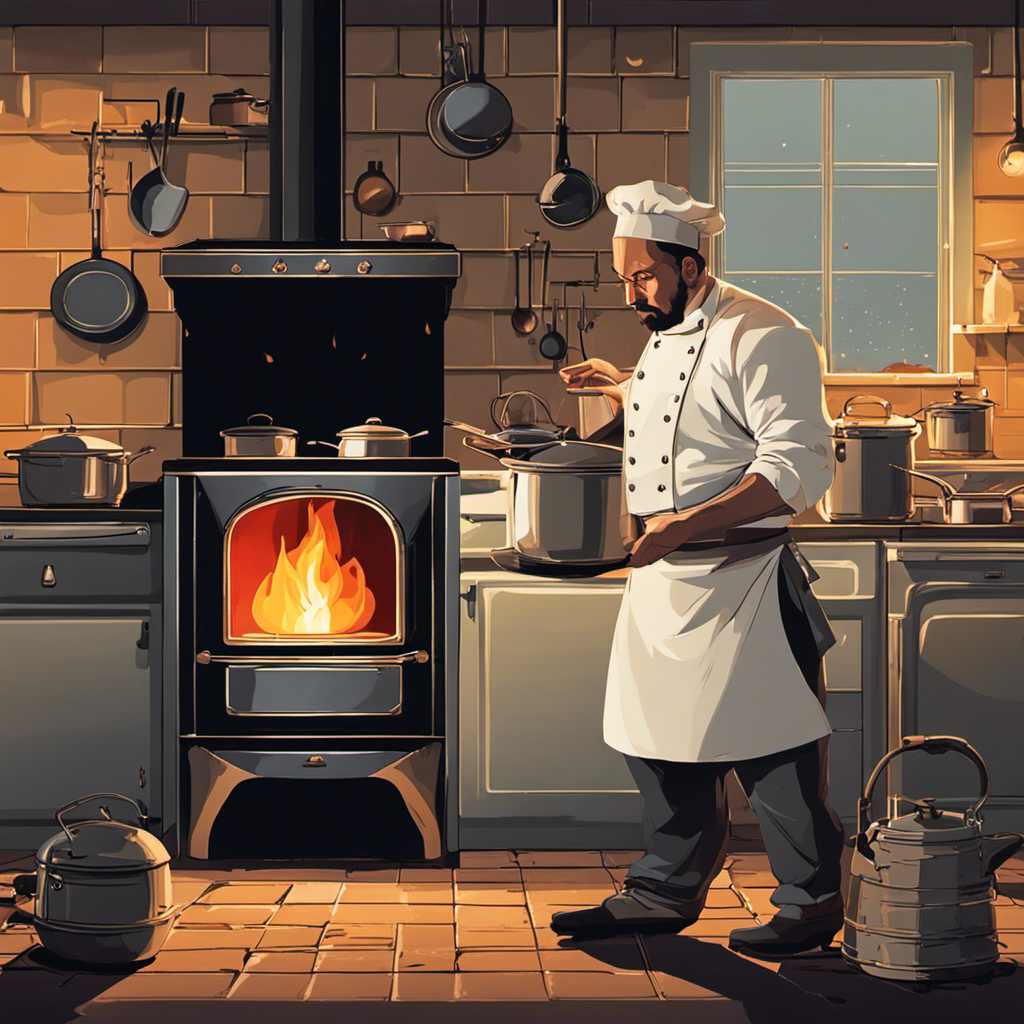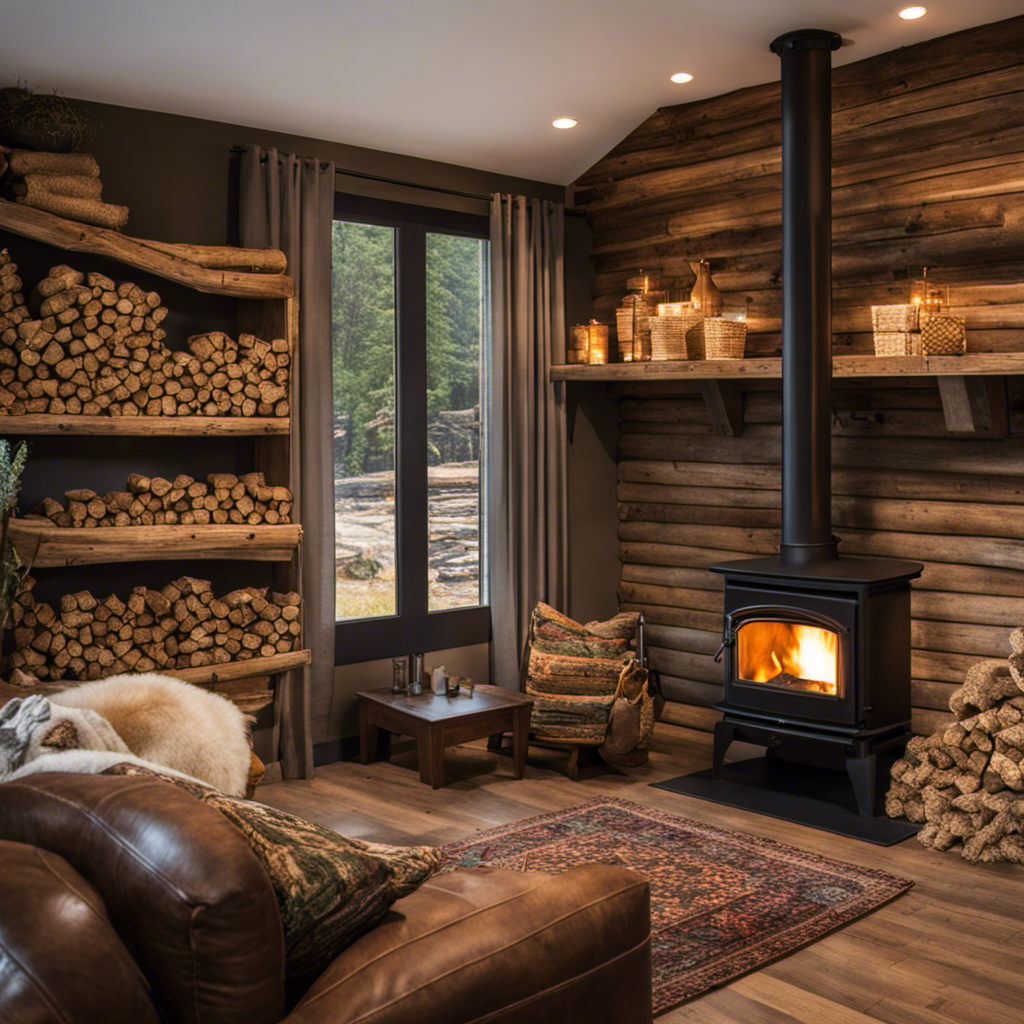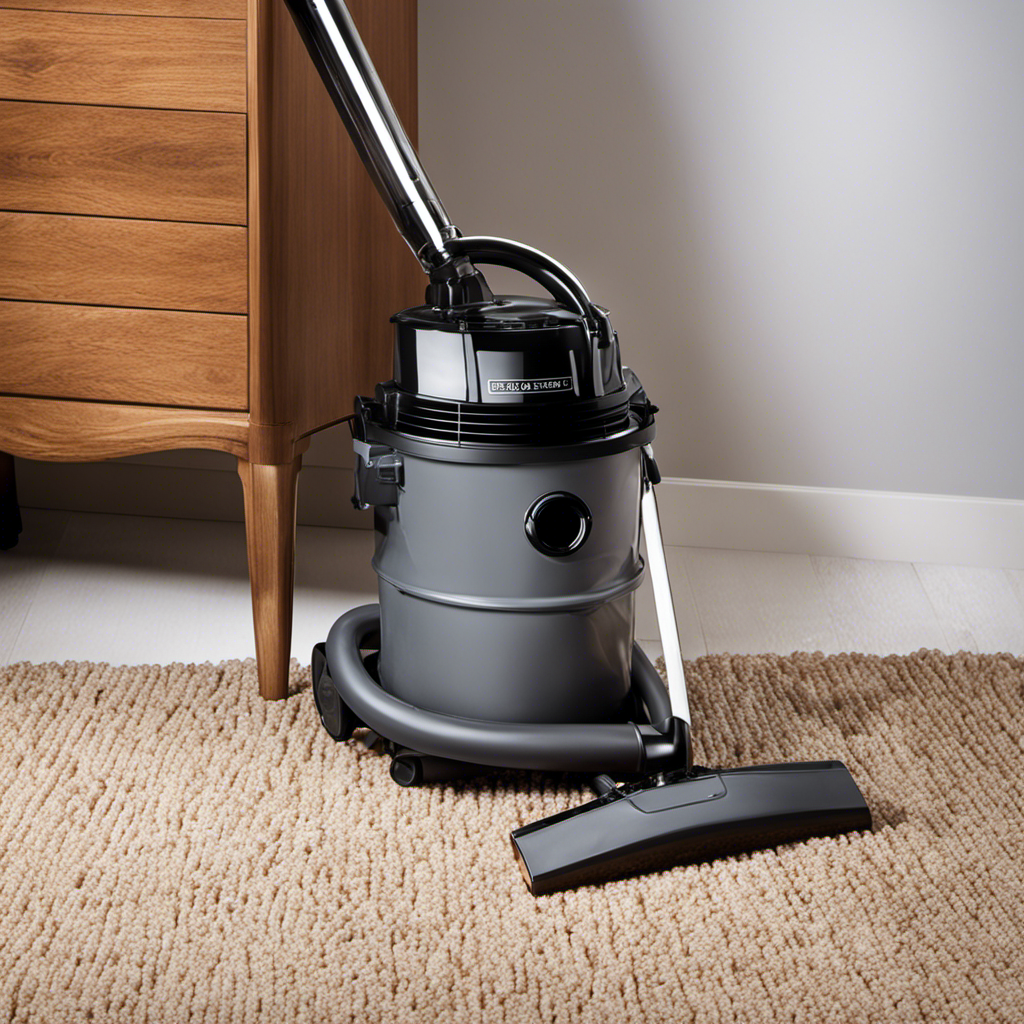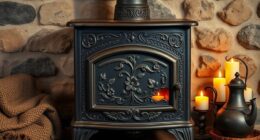After an exhaustive study on the subject, I can confidently state that deciding between a wood-burning stove and a pellet stove is a complicated choice. Each option has its advantages and disadvantages, highlighting the necessity to thoughtfully evaluate factors such as cost, performance efficiency, environmental impact, and other relevant issues.
In this article, we will delve into these aspects to help you make an informed choice. So sit back, relax, and let’s explore which stove type reigns supreme in the battle of warmth and sustainability.
Key Takeaways
- Pellet stoves are more cost-effective and efficient than wood-burning stoves.
- Pellet stoves have a lower environmental impact and contribute to cleaner air quality.
- Wood-burning stoves excel in heating large areas or homes with open floor plans.
- Pellet stoves offer convenience in fuel availability and require less space for storage.
Cost and Efficiency Comparison
If you’re looking for a cost-effective and efficient option, a pellet stove may be the better choice. When it comes to heating cost, pellet stoves have an advantage over wood burning stoves. Pellets are generally cheaper and more readily available than firewood, making them a more affordable fuel source in the long run.
Additionally, pellet stoves are known for their energy efficiency. They burn pellets at higher temperatures, resulting in more complete combustion and less wasted heat. This means that you can maximize your heating output while minimizing your energy consumption. With their advanced technology and precise control systems, pellet stoves offer a high level of efficiency compared to traditional wood burning stoves.
Transitioning into the next section about environmental impact, it’s important to consider not only cost but also how our choices affect the world around us.
Environmental Impact
The environmental impact of a wood-burning stove and a pellet stove differ significantly. While both stoves are considered renewable energy sources, the carbon footprint they leave behind varies greatly.
Wood-burning stoves emit more carbon dioxide, particulate matter, and other pollutants into the atmosphere compared to pellet stoves. This is because pellets are made from compressed sawdust and agricultural waste, which burn cleaner and produce fewer emissions.
By choosing a pellet stove over a wood-burning one, you can significantly reduce your environmental impact and contribute to cleaner air quality.
Now, let’s transition into the next section about heating capacity and performance without skipping a beat.
Heating Capacity and Performance
When choosing between a wood-burning stove and a pellet stove, it’s important to consider their heating capacity and performance. Here are three key factors to keep in mind:
-
Heating Power: Wood-burning stoves have been used for centuries due to their high heat output. They can quickly warm up a room and provide efficient heat throughout the space. On the other hand, pellet stoves have advanced technology that allows for precise temperature control. They offer consistent heat output without the need for constant fuel adjustments.
-
Heating Performance: Wood-burning stoves excel in heating large areas or homes with open floor plans. The radiant heat they produce creates a cozy ambiance and can even warm adjacent rooms. Pellet stoves, on the other hand, are more suitable for smaller spaces or well-insulated homes due to their ability to circulate warm air through ducting systems.
-
Efficiency: Both wood-burning and pellet stoves have made significant advancements in terms of efficiency. Modern wood-burning stoves often feature secondary combustion systems that maximize fuel burn and reduce emissions. Pellet stoves use compressed pellets made from recycled materials, resulting in cleaner combustion and higher overall efficiency.
Considering these factors will help you make an informed decision based on your specific heating needs and preferences.
Moving onto "fuel availability and accessibility," another important aspect to consider…
Fuel Availability and Accessibility
When comparing wood and pellet stoves, one important factor to consider is the accessibility of the fuel. Wood, being a traditional fuel source, is generally widely available in many regions. However, it does require proper storage and seasoning before use.
On the other hand, pellets are manufactured from compressed sawdust or other biomass materials and can be easily purchased in bags or bulk. Additionally, they tend to have consistent moisture content and burn efficiency.
Wood Vs Pellet Accessibility
Wood burning stoves can be easily found at most hardware stores, but pellet stoves may require a bit more searching. When it comes to accessibility, here’s what you need to know:
-
Wood:
-
Requires ample space for fuel storage, as logs need to be stored in a dry area.
-
Can be sourced locally from fallen trees or purchased from firewood suppliers.
-
May require seasoning the wood for optimal burning efficiency.
-
Requires manual chopping and splitting of logs before use.
-
May produce more ash and require regular cleaning.
-
Pellets:
-
Require less space for fuel storage as they come in compact bags.
-
Can be purchased from specialized retailers or online.
-
Are made from compressed sawdust and other biomass materials.
-
Provide consistent heat output due to standardized sizing and moisture content.
-
Require minimal maintenance compared to wood.
Considering these factors, let’s now delve into the comparison of fuel availability between wood and pellets.
Fuel Availability Comparison
If you’re considering fuel availability, it’s important to know where you can easily find the necessary materials for your stove. When comparing wood burning stoves and pellet stoves, one key factor to consider is the availability of fuel.
Wood can be sourced from various places such as local suppliers, forests, or even your own property if you have access to trees. On the other hand, pellets are usually made from compacted sawdust and other wood byproducts that are widely available at stores specializing in heating supplies.
In terms of cost, wood is generally cheaper than pellets. However, when it comes to environmental sustainability, pellets have an advantage as they are made from recycled materials and produce lower emissions compared to burning raw wood logs.
Now that we’ve discussed fuel availability and costs, let’s move on to maintenance and cleaning requirements.
Maintenance and Cleaning Requirements
Regular maintenance and cleaning are necessary for both wood burning stoves and pellet stoves. Keeping these appliances in good condition helps ensure their efficiency and longevity. Here are three key aspects to consider when it comes to maintaining and cleaning your stove:
-
Maintenance Costs: While wood burning stoves generally require less maintenance, they can incur higher costs due to the need for chimney sweeping and occasional repairs or replacement of firebrick lining. On the other hand, pellet stoves may require more regular servicing, such as cleaning out ash residue from the burn pot and auger system, which can be done by homeowners themselves.
-
Cleaning Frequency: Wood burning stoves should be cleaned at least once a year before winter use to remove creosote buildup in the chimney that could lead to potential fire hazards. Pellet stoves, however, typically require weekly cleaning to prevent ash accumulation that could affect performance.
Proper maintenance and regular cleaning not only help reduce maintenance costs but also ensure efficient operation of both wood burning stoves and pellet stoves. When considering installation options for these heating appliances…
Installation Considerations
When it comes to installing a wood burning or pellet stove, there are several key considerations that need to be addressed.
First and foremost is the space requirements – you’ll need to ensure that you have enough room in your home for the stove and all necessary clearance distances.
Next, ventilation options must be examined carefully, as proper venting is crucial for both safety and efficiency.
Lastly, cost considerations play a significant role in the decision-making process, as both the upfront installation costs and long-term operating expenses can vary greatly depending on the type of stove chosen.
Space Requirements
The pellet stove requires less space than the wood burning stove. When considering the installation of a stove in your home, it’s important to take into account the space requirements of each option. A wood burning stove typically needs more room due to its larger size and the need for proper clearance from combustible materials. On the other hand, a pellet stove is generally more compact and can be installed in smaller spaces.
To give you a clearer picture, here is a table comparing the space requirements for both types of stoves:
| Stove Type | Space Requirements |
|---|---|
| Wood Burning Stove | Larger |
| Pellet Stove | Smaller |
As you can see, if space is limited in your home, a pellet stove may be the better choice. It offers a more efficient use of space while still providing ample heat for your living area.
Now let’s move on to discuss ventilation options without skipping a beat.
Ventilation Options
When it comes to ventilation options for wood burning stoves and pellet stoves, there are a few important installation considerations to keep in mind. Here are four key points to consider:
-
Chimney: Wood burning stoves require a traditional chimney system, while pellet stoves can be vented through a wall or roof using a smaller pipe.
-
Clearances: Both types of stoves require proper clearances to combustible materials, such as walls and furniture. Make sure you adhere to the manufacturer’s guidelines for safe installation.
-
Combustion air: Wood burning stoves usually draw air from inside the home, so adequate ventilation is necessary. Pellet stoves typically have an external air intake that brings in fresh air from outside.
-
Professional installation: Due to the complexities of properly venting these appliances, it is recommended to hire a professional installer who can ensure everything is done correctly and safely.
Considering all these factors will help you make an informed decision when choosing between a wood burning stove and a pellet stove.
Now let’s move on to cost considerations without further ado…
Cost Considerations
To make an informed decision, you should take into account the cost considerations of both options.
When it comes to installation cost, a wood burning stove tends to be more expensive than a pellet stove. Wood stoves require a chimney or flue system to be installed, which can add to the overall cost.
On the other hand, pellet stoves usually come with a venting system that can be easily installed through an exterior wall.
In terms of fuel cost, wood stoves have an advantage as wood is generally cheaper and more readily available than pellets. However, pellets are more efficient and provide consistent heat output due to their uniform size and density. This efficiency can help offset the higher initial investment in pellets.
Transitioning into the next section about safety features and concerns, it is important to consider these factors alongside the costs involved in owning either type of stove.
Safety Features and Concerns
Both wood burning stoves and pellet stoves have safety features that can help prevent accidents. When it comes to safety precautions, here’s what you need to know:
-
Automatic shut-off: Both types of stoves are equipped with an automatic shut-off feature that activates when the stove reaches a certain temperature or if there is a malfunction.
-
Safety screens: Wood burning stoves come with safety screens that prevent sparks from escaping and causing fires.
-
Clearances: Both stoves require specific clearances from combustible materials to reduce the risk of fire.
-
Carbon monoxide detectors: It is recommended to install carbon monoxide detectors near the stove area to detect any harmful gas emissions.
-
Smoke emissions: Pellet stoves produce less smoke emissions compared to wood burning stoves, making them a safer option for indoor use.
Considering these safety features and concerns, it’s important to also consider the aesthetics and design options available for both types of stoves.
Aesthetics and Design Options
When it comes to choosing a stove for your home, two key factors to consider are style and ambiance. The design of a stove can greatly impact the overall aesthetic of a room, whether you prefer a rustic, traditional look or a sleek, modern vibe.
Additionally, customization and versatility are important aspects to consider when selecting a stove, as they allow you to personalize the appliance to fit your specific needs and preferences. From different finishes and colors to various heating options and features, there are plenty of choices available to create the perfect stove for your home.
Style and Ambiance
If you want to create a cozy and rustic atmosphere in your home, a wood burning stove is the way to go. Not only does it provide warmth, but it also adds a touch of charm to any room. When it comes to heating performance, wood burning stoves are known for their excellent heat output. They can efficiently heat large spaces and keep them warm for extended periods of time.
In terms of fuel efficiency, wood burning stoves can be quite efficient if they are properly maintained and used with seasoned firewood. Here are four reasons why wood burning stoves excel in heating performance and fuel efficiency:
-
High Heat Output: Wood burning stoves generate intense heat that can quickly warm up even the coldest rooms.
-
Radiant Heat: These stoves emit radiant heat, which warms objects directly without wasting energy on heating the air.
-
Efficient Combustion: Wood burning stoves are designed to burn wood efficiently, minimizing waste and maximizing heat production.
-
Zone Heating: With a wood burning stove, you have the ability to selectively heat specific areas of your home, reducing overall energy consumption.
With all these benefits in mind, let’s now explore the customization and versatility options available with wood burning stoves…
Customization and Versatility
One advantage of wood burning stoves is that they can be customized to fit the aesthetic of any room in your home. With a wide range of customization options available, you can choose from different sizes, styles, and finishes to match your personal taste and decor. Whether you prefer a traditional or modern look, there’s a wood burning stove design for everyone.
In addition to their customization options, wood burning stoves also offer heating versatility. They are capable of generating significant heat output and can efficiently warm up large spaces. This makes them an excellent choice for homeowners looking for a reliable heating solution during colder months.
Transitioning into the next section about ‘noise level and operation,’ it’s important to consider not only the style and heating capabilities but also how these stoves function in terms of noise level and operation.
Noise Level and Operation
You’ll notice that the noise level of a pellet stove is generally quieter compared to a wood-burning stove. Here are some reasons why this matters:
- Peaceful environment: Enjoy the warmth and ambiance without the distractions of loud crackling or popping sounds.
- Better sleep quality: A quiet pellet stove won’t disrupt your rest, ensuring you wake up refreshed.
- Enhanced relaxation: Unwind after a long day in tranquility, as the gentle hum of a pellet stove soothes your senses.
- Improved focus: Whether reading, working, or spending time with loved ones, a quieter stove allows for better concentration.
In addition to its noise level, pellet stoves offer various ventilation options and safety features to ensure optimal performance and peace of mind.
Now let’s delve into the next topic – longevity and durability – where we’ll explore how these stoves stand the test of time.
Longevity and Durability
To ensure that your stove lasts for many years, it’s important to regularly maintain and clean the various components. When comparing the longevity and durability of wood burning stoves versus pellet stoves, several factors come into play. Wood burning stoves generally have a longer lifespan compared to pellet stoves due to their simpler design and fewer mechanical parts. However, pellet stoves are built with durable materials such as stainless steel or cast iron, which enhances their durability. Additionally, wood burning stoves require regular cleaning of the chimney to prevent creosote buildup, while pellet stoves need periodic maintenance of the auger system and ash removal. Here is a comparison table highlighting the key aspects of longevity and durability for both types of stoves:
| Longevity | Durability | |
|---|---|---|
| Wood Burning | Longer lifespan | Fewer mechanical parts |
| Pellet | Durable materials used | Maintenance of auger system |
Frequently Asked Questions
How Do Wood Burning Stoves and Pellet Stoves Compare in Terms of Heating Quality and Comfort?
In terms of heating quality and comfort, wood burning stoves and pellet stoves can be compared based on their efficiency and cost. Efficiently, pellet stoves offer better control over heat output. Cost-wise, wood burning stoves are generally cheaper to operate.
Are Wood Burning Stoves or Pellet Stoves More Suitable for Large Spaces?
In terms of heating large spaces, it’s important to consider both the energy efficiency and cost effectiveness of wood burning stoves versus pellet stoves. Let’s explore these factors in more detail.
Can Pellet Stoves Be Used as a Primary Heating Source or Are They Only Effective as a Supplemental Heat Source?
As a primary heating source, pellet stoves have their advantages and disadvantages. They can effectively heat a home, but may not be as efficient or cost-effective as a traditional furnace. A thorough cost comparison is recommended before making a decision.
What Are the Different Types of Wood and Pellets Available for Burning in These Stoves, and How Do They Affect Their Performance?
Different types of wood and pellets for stoves, such as moisture content, density, and species, can significantly impact their performance. Additionally, comparing the environmental impact of wood burning stoves and pellet stoves reveals differences in emissions, sustainability, and use of renewable resources.
Are There Any Potential Health Risks Associated With Using Wood Burning Stoves or Pellet Stoves?
There are potential health risks associated with both wood burning stoves and pellet stoves. Comparing emissions, pellet stoves produce fewer pollutants than wood burning stoves, making them a slightly safer option.
Conclusion
After carefully considering the various factors, it is clear that in terms of cost, efficiency, and environmental impact, the pellet stove emerges as the better option.
With its automated fuel delivery system and higher heating capacity, it offers convenience and effectiveness.
While wood burning stoves have their charm and aesthetic appeal, they require more maintenance and cleaning.
Moreover, pellet stoves come with advanced safety features that make them a safer choice.
Ultimately, the decision between the two boils down to personal preferences and priorities.

